Kurukshetra March, 2025
Chapter 1-Union Budget 2025-26: Development Dimensions
Introduction
The Economic Survey 2024-25, tabled in Parliament, highlighted India’s steady economic growth amid global manufacturing slowdowns. Citizens’ expectations from the budget included income growth, employment, infrastructure development, and an enabling business environment.
- The Union Budget 2025-26 aligns with the Economic Survey 2024-25, emphasizing resilient growth amid global manufacturing slowdowns (Europe/Asia) and supply chain disruptions.
- It prioritizes rural development, agriculture, and inclusive growth to achieve Viksit Bharat by 2047, aiming for India to become a global economic powerhouse with sustainability and equity.
Key Budget Highlights
- Higher Allocation & Development Push:
- Total expenditure: Rs. 50.65 lakh crore (2025-26 BE) vs. Rs. 47.16 lakh crore (2024-25 RE).
- Effective capital expenditure: Rs. 15.48 lakh crore (2025-26) vs. Rs. 10.18 lakh crore (2024-25 RE).
- Vision of ‘Viksit Bharat 2047’: Sustainable, inclusive growth through infrastructure, social welfare, and economic reforms.
- Rural Development Allocation: Rs. 1.87 lakh crore (↑5.75% from 2024-25).
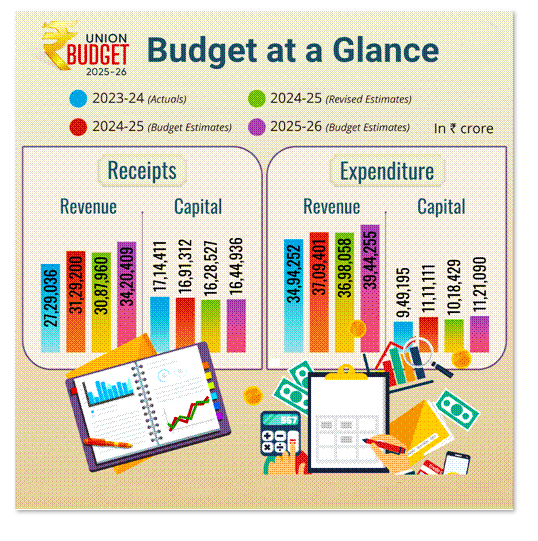
- Sectoral Allocations & Priorities:
- Skill Development & Entrepreneurship (↑35%) leads the priority list.
- Other increases: Rural Development (5.7%), MSME (4.7%), Agriculture & Farmers’ Welfare (3.9%), Women & Child Development (3.1%).
- Rs. 3.83 lakh crore allocated for food & fertilizer subsidies, rural development, employment, and skill programs.
Key Sectoral Interventions
1. Agriculture & Farmers’ Welfare
- PM Dhan-Dhaanya Krishi Yojana: Integrated agriculture development in 100 districts.
- Focus on crop diversification, sustainable farming, irrigation, post-harvest infrastructure, and farmer credit access.
- Reduction in Urea Subsidy, shift to nutrient-based subsidies to promote organic farming & soil health.
- PM Krishi Sinchai Yojana (PMKSY): Rs. 8,260 crore for improved irrigation & water conservation.
2. Food Processing & Rural Enterprises
- PM Formalization of Micro Food Processing Enterprises (PMFME) Scheme (↑4.8%) for technology upgrades, quality improvements, and market linkages.
3. Rural Employment & Livelihoods
- MGNREGA: Retained at Rs. 86,000 crore, with emphasis on better execution & asset creation.
- DAY-NRLM: Allocation increased by 26.3% (Rs. 19,005 crore) for women entrepreneurship & skill development.
Conclusion
Budget 2025-26 reflects India’s commitment to rural development, agriculture, infrastructure, and human capital investment. Higher allocations aim to boost productivity, job creation, entrepreneurship, and sustainable economic growth, aligning with the long-term vision of ‘Viksit Bharat 2047’.
Chapter 2-Government Initiatives to Boost Rural Economy
The rural economy is crucial to India’s employment and GDP. To boost inclusive growth and livelihoods, the government focuses on agriculture, MSMEs, fisheries, and self-reliance initiatives.
- Key measures include enhancing rural infrastructure, increasing consumption, and fiscal policies to strengthen economic activities.
Government’s Fiscal Strategy for Economic Growth
The government aims to drive economic growth by enhancing revenue collection and public expenditure. A higher tax collection target enables increased public spending, which in turn stimulates demand in a consumption-driven economy like India.
Taxation and Revenue Targets
For FY 2025-26, the government has set an ambitious revenue collection target of Rs. 42.70 lakh crore, marking an 11% increase over the previous year. The breakdown is as follows:
- Direct Tax Collection Target: Rs. 25.20 lakh crore (from income tax and corporate tax).
- Indirect Tax Collection Target: Rs. 17.50 lakh crore (from GST, excise duty, and customs).
Higher tax revenues ensure greater fiscal space for public investment, allowing the government to allocate more funds towards rural development schemes, infrastructure, and welfare programs.
Economic Growth and Associated Challenges
Current Growth Projections
The National Statistical Office (NSO) and the Reserve Bank of India (RBI) project India’s GDP growth rate as follows:
- 2024-25: 6.4% (NSO), 6.6% (RBI).
- 2025-26: 6.7% (RBI).
Despite positive growth trends, the economy has witnessed a slowdown in the last two quarters. This necessitates strong interventions in investment, consumption, and exports to sustain long-term growth.
Key concerns include:
- Declining rural demand, particularly in agriculture-dependent regions.
- Slow growth in MSME and informal sectors affecting employment generation.
- Supply chain bottlenecks, especially in logistics and storage.
To address these concerns, the government has rolled out several initiatives to increase farmers’ income, promote agro-industries, and enhance financial access for rural entrepreneurs.
Budgetary Measures to Strengthen the Rural Economy
1. Increased Allocation for Agriculture and Allied Sectors
The government has allocated Rs. 2.66 lakh crore for agriculture and allied sectors, an increase of Rs. 1000 crore from the previous year. The aim is to enhance agricultural productivity, improve market linkages, and ensure fair prices for farmers.
Key initiatives include:
2. Expansion of Kisan Credit Card (KCC) Loans
- The KCC loan limit has been increased from Rs. 3 lakh to Rs. 5 lakh, benefiting 7.75 crore farmers across the country.
- This initiative provides farmers with easy access to credit at lower interest rates, helping them manage input costs, invest in better technology, and mitigate financial distress.
3. Pradhan Mantri Dhan-Dhaanya Krishi Yojana
- Focuses on 100 low-yield districts to improve productivity through:
- Financial assistance for better-quality seeds, fertilizers, and irrigation
- Enhanced storage and logistics support to prevent post-harvest losses.
- Market access improvements to ensure farmers get fair prices.
- This scheme aims to benefit 1.7 crore farmers and reduce regional agricultural disparities.
4. Cotton and Pulses Missions
- 5-year Cotton Technology Mission:
- Aims to improve cotton quality and yield.
- Focus on introducing high-yielding seed varieties and better irrigation techniques.
- 6-year Pulses Mission:
- Targets self-sufficiency in pulses like tur, urad, and masoor.
- Includes a 100% procurement guarantee through NAFED and NCCF, ensuring price stability for farmers.
5. Boosting the Fisheries Sector
Fisheries contribute significantly to India’s economy, with India being the second-largest producer of aquaculture fish. The government is introducing:
- Special Economic Zones (SEZs) for fisheries to boost exports and employment.
- Subsidized credit and infrastructure development for fisherfolk.
These measures will enhance inland and marine fisheries, increasing rural employment opportunities.
6. Promoting MSMEs and Ease of Doing Business
MSMEs are crucial for employment generation in rural and semi-urban areas. The government aims to:
- Simplify business laws and remove regulatory hurdles to encourage entrepreneurship.
- Expand financial support through subsidized credit schemes and digital banking.
- Boost rural industries like handicrafts and food processing to enhance local employment.
The focus is on expanding credit access and easing compliance, enabling small businesses to thrive in rural areas.
7. Self-Reliance in Urea Production
To reduce import dependence and ensure affordable fertilizer supply, the government has:
- Proposed setting up new urea manufacturing plants.
- Aimed at stabilizing fertilizer prices for farmers.
- Promoted the use of nano-fertilizers to improve soil health.
This initiative aligns with Atmanirbhar Bharat, reducing costs for farmers while ensuring adequate fertilizer supply.
Conclusion
The government’s rural economic strategy emphasizes agriculture, MSMEs, fisheries, infrastructure, and financial empowerment. Increased budgetary support, credit access, and productivity enhancements aim to boost incomes, employment, and rural industries. Effective implementation can drive sustainable growth, reduce the rural-urban divide, and support India’s $5 trillion economy vision.
Chapter 3-Budgetary Initiatives for Women Empowerment in India
Women’s empowerment is a crucial aspect of inclusive development, ensuring gender equality and economic participation. Budgetary provisions aimed at women’s welfare play a pivotal role in achieving these objectives. Over the years, India has implemented gender-responsive budgeting (GRB) to allocate resources effectively for women’s development.
Gender Budgeting in India
Introduced in 2005-06, Gender Budgeting (GB) is an analytical tool to assess the impact of government budgets on women and ensure gender equity. It focuses on planning, allocating, and auditing public expenditure to address gender disparities across sectors.
- It focuses on planning, allocating, and auditing public expenditure to address gender disparities across sectors.
Objectives of Gender Budgeting:
- Enhancing women’s participation in economic activities.
- Ensuring better access to education, healthcare, and social welfare schemes.
- Addressing gender gaps in workforce participation and wages.
- Strengthening institutional frameworks for gender mainstreaming in policies.
Key Budgetary Initiatives for Women Empowerment
1. Beti Bachao Beti Padhao (BBBP)
Launched in 2015, this scheme aims to address declining child sex ratios and promote education for girls. The initiative works through coordinated efforts of education, health, and social sectors.
2. National Mission for Empowerment of Women (NMEW)
A holistic scheme to facilitate inter-ministerial coordination for policy-making, implementation, and monitoring of women-centric programs.
3. Pradhan Mantri Matru Vandana Yojana (PMMVY)
A conditional cash transfer scheme providing financial support to pregnant and lactating women for improved health and nutrition.
4. Mahila Shakti Kendra (MSK)
A grassroots-level initiative offering skill development, employment opportunities, and digital literacy to rural women.
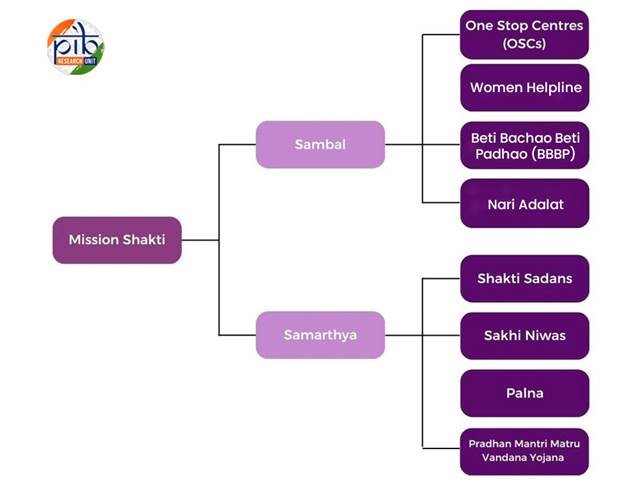
5. One Stop Centres (OSCs)
Established to provide integrated support to women facing violence, including legal aid, medical assistance, and counseling.
6. Working Women Hostel Scheme
Aims to provide safe and affordable accommodation for working women, particularly in urban areas.
7. National Creche Scheme
Supports working mothers by providing daycare facilities for children, facilitating women’s workforce participation.
8. Support to Training and Employment Programme for Women (STEP)
Enhances women’s skills through vocational training, increasing their employability in various sectors.
Impact of Gender Budgeting
- Increased Female Workforce Participation: Policies like MGNREGA and Mudra Yojana have contributed to higher employment rates for women.
- Improved Health Outcomes: Maternal mortality rates have declined due to healthcare schemes like PMMVY and Janani Suraksha Yojana.
- Enhanced Financial Inclusion: The rise in women-led enterprises, backed by credit support under Stand-Up India and self-help group (SHG) programs.
- Reduction in Gender-Based Violence: Schemes like OSCs and Women Helpline have strengthened institutional mechanisms to protect women’s rights.
Challenges:
Despite progress, several challenges remain:
- Insufficient Allocation: Budgetary constraints limit the scope of gender-responsive programs.
- Lack of Awareness: Women in rural areas remain unaware of available schemes.
- Poor Monitoring & Evaluation: Gaps in implementation and accountability hinder effectiveness.
- Societal Barriers: Patriarchal norms still restrict women’s participation in decision-making.
Way Forward
- Increased Budgetary Allocation: A higher percentage of the GDP should be earmarked for womencentric programs.
- Strengthening Institutional Frameworks: Gender-sensitive governance and policy implementation need to be reinforced.
- Capacity Building & Awareness: Grassroots campaigns and digital literacy programs can bridge information gaps.
- Incentivizing Women’s Participation: Policies should encourage women’s entrepreneurship and leadership roles in governance.
Conclusion
Budgetary initiatives for women’s empowerment are essential for inclusive and sustainable development. While significant strides have been made, enhanced resource allocation, effective implementation, and societal change are required to bridge gender gaps. A comprehensive approach, combining policy reforms with financial support, will ensure that women play an equal role in India’s socio-economic progress.
Chapter 4- Strengthening Healthcare Infrastructure and Access
The Union Budget 2025-26 underscores the government’s commitment to strengthening healthcare access and infrastructure, with significant allocations for medical education, cancer care, digital health initiatives, and medical tourism.
Key Budgetary Allocations and Initiatives
1. Increased Health Budget
- The Ministry of Health and Family Welfare has been allocated Rs. 99,858.56 crore, an 11% increase from the previous year.
- Rs. 95,957.87 crore for the Department of Health & Family Welfare and Rs. 3,900.69 crore for the Department of Health Research.
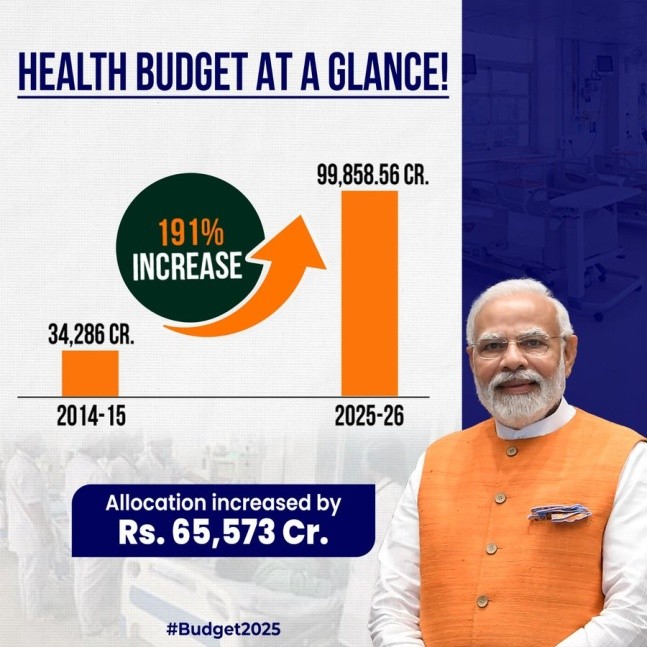
2. Medical Education Expansion
- Addition of 10,000 medical seats in the coming year, with a target of 75,000 new seats over five years.
- Aims to address the doctor shortage and strengthen public healthcare, particularly in rural areas.
3. Cancer Care and Day-Care Cancer Centres
- 200 district-level day-care cancer centres to be set up within three years, improving access to treatment in tier-2 and tier-3 cities.
- Expected to reduce the financial burden on patients and decentralize healthcare services.
4. Ayushman Bharat Initiative
- Ayushman Arogya Mandir: Establishment of wellness centers focusing on preventive healthcare and early diagnosis.
- PM-JAY (Ayushman Bharat Yojana): Increased allocation to expand financial protection against catastrophic health expenditures, covering Rs. 5 lakh per family annually.
- PM-ABHIM (Health Infrastructure Mission): Strengthening critical care units, public health labs, and disease surveillance systems (Rs. 4,758 crore allocated).
- Ayushman Bharat Digital Mission (ABDM): Promoting digital health records and seamless healthcare access.
5. Medical Tourism and Global Healthcare Hub
- “Heal in India” initiative to simplify visa procedures, upgrade medical facilities, and promote private-public partnerships.
- Aims to boost India’s position as a global destination for quality healthcare services.
6. Social Security for Gig and Platform Workers
- Identity cards and registration on the e-Shram portal to formalize gig workers.
- Health coverage under PM-JAY to provide medical security
- Potential pension and social welfare benefits for financial stability.
7. Customs Duty Exemptions for Life-Saving Drugs
- 36 life-saving medicines fully exempted from basic customs duty
- 6 additional medicines at concessional 5% customs duty to make essential drugs more affordable.
Significance and Implications
- Addresses doctor shortages and strengthens India’s medical education framework.
- Enhances cancer care accessibility, reducing the burden on metro hospitals.
- Strengthens digital health infrastructure, enabling seamless patient records and diagnosis.
- Boosts medical tourism, increasing foreign exchange earnings and healthcare investments.
- Ensures financial protection for vulnerable groups, including gig workers and underprivileged patients.
Conclusion
The Union Budget 2025-26 prioritizes a holistic healthcare approach, integrating infrastructure expansion, medical education, digital transformation, and financial inclusion. These initiatives align with universal health coverage goals, reinforcing India’s long-term vision of a resilient and inclusive healthcare system.
Chapter 5- Union Budget 2025-26: A Boost to Swachh Bharat and Jal Jeevan Missions
The Union Budget 2025-26 underscores the government’s commitment to sustainable development, particularly in sanitation and water security. With an increased focus on flagship schemes like the Swachh Bharat Mission (SBM) and the Jal Jeevan Mission (JJM), the budget aims to accelerate India’s progress towards universal sanitation coverage and potable water accessibility
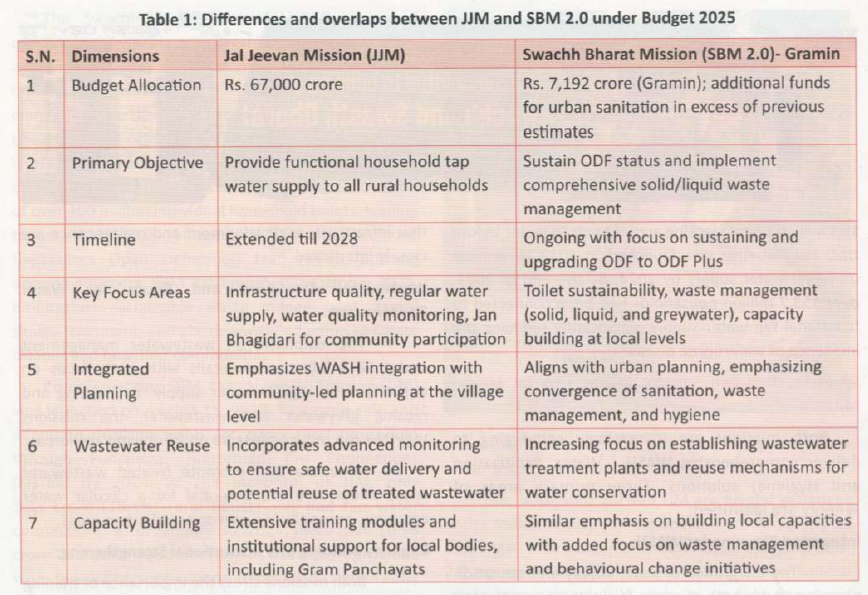
Budgetary Allocations and Key Announcements
Swachh Bharat Mission (SBM)
- Increased Allocation: The SBM has received a budgetary allocation of Rs X crore, reflecting a Y% increase from the previous year. This increment is directed towards ensuring 100% solid and liquid waste management in rural and urban areas.
- Urban Sanitation Drive: Special emphasis is placed on urban sanitation, with incentives for waste segregation at the source, waste-to-energy projects, and scientific landfill management.
- ODF Plus Villages: The government continues its focus on making villages Open Defecation Free (ODF) Plus, emphasizing greywater management and faecal sludge treatment.
- Behavioral Change Initiatives: A renewed push is given to behavioral change campaigns through community-led awareness programs to sustain sanitation gains.
Jal Jeevan Mission (JJM)
- Higher Budgetary Support: The JJM, which aims to provide piped water to every rural household by 2026, has seen an allocation of Rs Z crore, up from Rs W crore last year.
- Technology Integration: Funds have been earmarked for sensor-based monitoring of water supply, ensuring realtime data collection for transparency and efficiency.
- Climate-Resilient Water Supply: A significant portion of the budget is dedicated to creating climate-resilient infrastructure, such as rainwater harvesting systems and groundwater recharge projects.
- Capacity Building and Skilling: Training programs for local water management committees have been expanded to improve community ownership and maintenance of water supply systems.
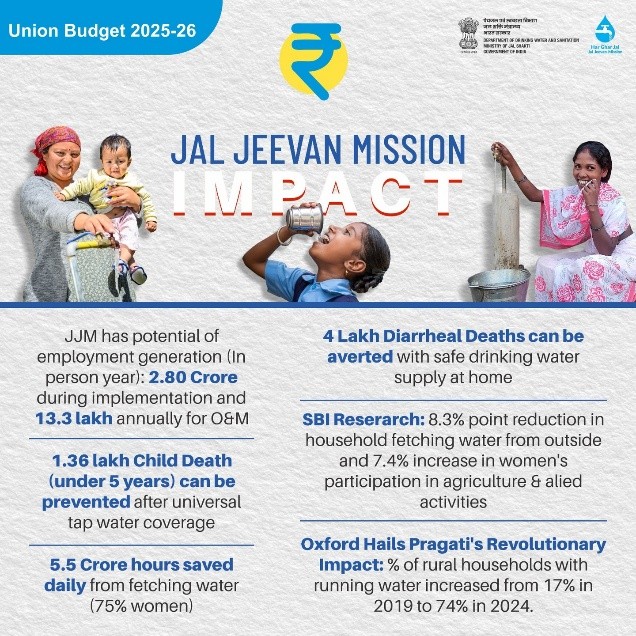
Why is This Important?
- Health and Hygiene Improvements: Improved sanitation and clean water access significantly reduce waterborne diseases, thereby improving public health indicators.
- Environmental Sustainability: Proper waste management and water conservation efforts contribute to environmental sustainability and resource efficiency.
- Rural and Urban Equity: The budget ensures that both rural and urban areas benefit from sanitation and water supply schemes, reducing disparities in public service delivery
- Employment Generation: Infrastructure development under SBM and JJM creates job opportunities, particularly in rural areas, through construction and maintenance activities.
Challenges and the Way Forward
- Implementation Gaps: Despite increased funding, challenges such as delays in fund disbursement and project execution need to be addressed.
- Quality Assurance: Ensuring water quality and sustainable sanitation practices remains a key concern, requiring stricter monitoring and evaluation.
- Community Participation: Greater community engagement is necessary to enhance the long-term sustainability of these initiatives.
- Innovative Financing Models: Leveraging public-private partnerships (PPP) and international funding sources can help bridge financial gaps.
Conclusion
The Union Budget 2025-26 reaffirms the government’s commitment to improving sanitation and water accessibility through the Swachh Bharat and Jal Jeevan Missions. While the increased funding and policy focus are commendable, their success hinges on effective implementation, quality assurance, and active community participation. With a holistic approach, these initiatives can significantly enhance public health, environmental sustainability, and socio-economic development in India.
Upsc Mains Practice Questions-(Around 250 Words)
Q.1. Rural credit remains a critical issue in India despite various government initiatives. Examine the challenges in rural credit accessibility and suggest measures to improve financial inclusion.
Q.2 The rise of non-communicable diseases (NCDs) in rural India is a growing concern. Examine the reasons behind this trend and suggest policy measures to address it.
Q.3 The success of Indian agriculture depends on water management. Discuss the role of micro-irrigation and watershed development in ensuring sustainable agriculture.